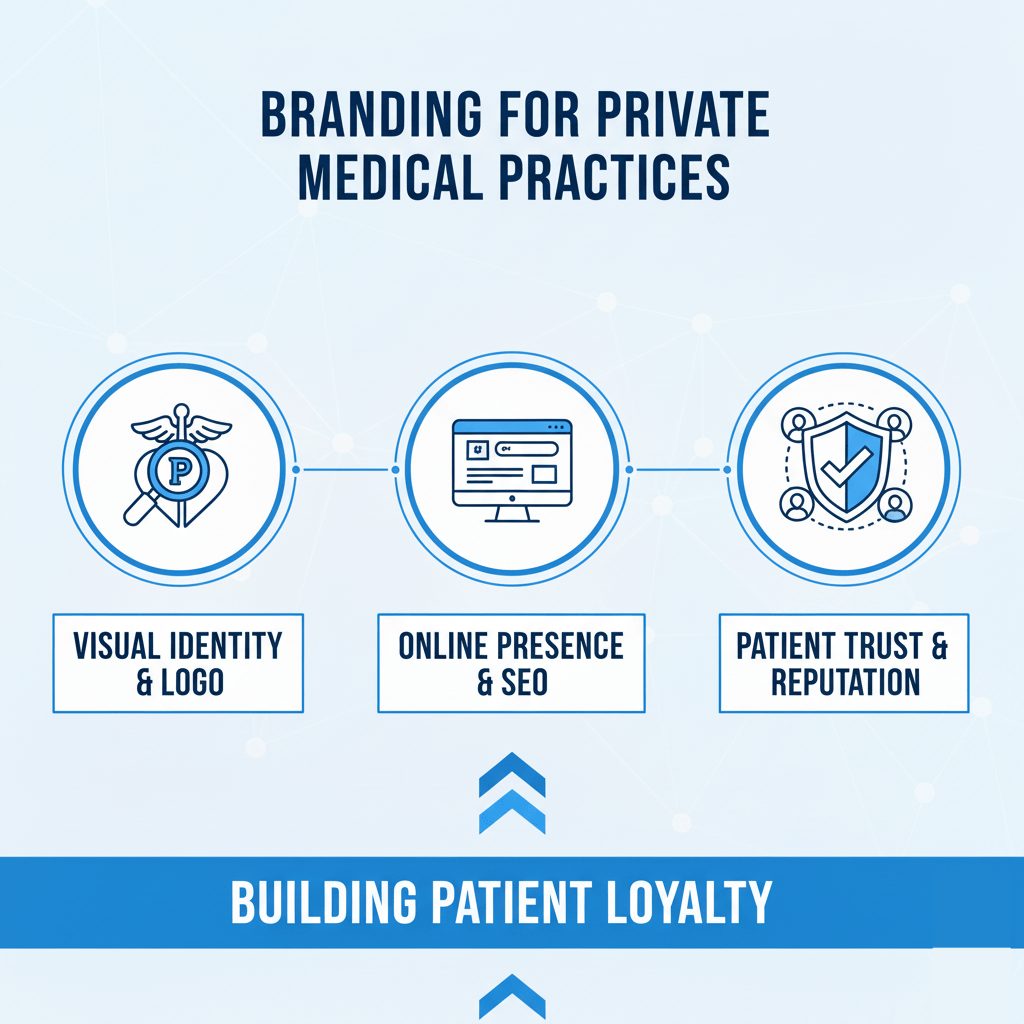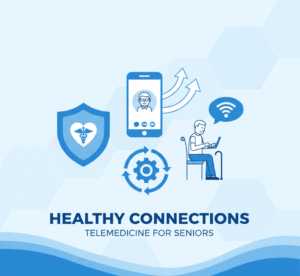“Define your unique identity, build digital trust, and master consistency across all online channels with this guide to Branding for Private Medical Practices.”
In the not-so-distant past, the success of a private medical practice hinged almost entirely on two things: a doctor’s reputation and word-of-mouth referrals. A physician earned respect through years of dedicated patient care, and that reputation spread through community networks, one satisfied patient at a time. The shingle hanging outside the office was the primary form of advertising. Today, that shingle is digital, and it’s visible to the entire world. The community network is now the internet, and word-of-mouth has transformed into online reviews, social media discussions, and the overall digital experience you provide.
Many practitioners believe that as long as they provide excellent medical care, the business side of things will take care of itself. Unfortunately, that’s no longer the case. The modern patient is also a contemporary consumer. Before they even think about booking an appointment, they go online. They search for their symptoms. They look up local doctors. They read reviews on Google, Healthgrades, and Vitals. They visit practice websites and scan social media profiles. In this new environment, your clinical expertise is the product, but your brand is the reason they choose to walk through your door—or click “book now”—in the first place.
This is where the concept of branding for private medical practices comes in. And let’s be clear from the start: branding is so much more than a professionally designed logo and a pleasant color scheme. Your brand is the entire ecosystem of patient perception. It’s the feeling a potential patient gets when they land on your website. It’s the tone of voice in your emails. It’s the story you tell through your blog posts. It’s the promise you make to your patients and the experience you deliver to back it up. A strong brand answers the critical question in a potential patient’s mind: “Is this the right doctor for me?”
This article offers a comprehensive examination of building a brand. We will move beyond the surface level and explore the foundational strategies that turn a simple medical practice into a trusted healthcare brand. We’ll cover how to define your unique identity, how to maintain that identity across every digital touchpoint, and how to use content to build relationships and trust. Finally, we’ll discuss how a strategic partner can help you put all these pieces together, creating a powerful online presence that not only attracts your ideal patients but also fosters lasting loyalty.
The Modern Patient’s Journey: Why Your Online Brand is Your New Front Door
Think about the last time you needed a service. You may be looking for a reliable plumber, a new accountant, or a great local restaurant. What was the first thing you did? You likely pulled out your phone and started searching. You read reviews, you looked at their websites, and you formed an impression long before you ever made a call. Your potential patients are doing the same thing. The patient journey no longer begins with a phone call to your receptionist; it starts with a Google search.
This fundamental shift makes your online identity for doctors the most critical asset in your marketing toolkit. Your digital presence is, for all intents and purposes, your new front door. Before a patient ever experiences your clean waiting room, friendly staff, or compassionate bedside manner, they encounter your website, social media profiles, and online reviews. This initial digital handshake is where trust begins—or where it crumbles.
The Power of the First Digital Impression
You would never let a patient walk into a waiting room with peeling paint, outdated magazines, and a disorganized front desk. You understand that the physical environment sets the tone for the entire visit. It communicates professionalism, cleanliness, and a commitment to patient comfort. Your digital environment works in precisely the same way.
A poorly designed, slow-loading, or mobile-unfriendly website sends a message. It might suggest that the practice is outdated, not technologically savvy, or simply doesn’t care about the patient experience. Broken links, blurry images, and a lack of clear information create friction and frustration. A potential patient struggling to find your phone number or understand the services you offer is unlikely to feel confident in your ability to manage their complex health needs. This initial negative impression can be enough to make them click the “back” button and check out your competitor down the street.
Conversely, a clean, professional, and easy-to-navigate website creates an immediate sense of trust and credibility. It communicates that you are organized, modern, and patient-focused. High-quality photos of you and your actual staff (not generic stock photos) build a personal connection. Clear, concise information about your services and philosophy shows that you respect the patient’s time and intelligence. This positive first impression makes them feel comfortable and confident, encouraging them to take the next step and schedule an appointment.
Building Trust Before the First Visit
Trust is the cornerstone of the doctor-patient relationship. In the traditional model, this trust was built over time, face-to-face in the examination room. In the digital age, we must start building that trust online. Your digital presence as a doctor is your primary tool for this.
How does this happen? It happens when a patient reads a blog post you wrote that clearly explains a complex medical condition they’ve been worried about. It happens when they see patient testimonials on your website that speak to your compassionate approach. It happens when they visit your Facebook page and see you actively engaging with your community and sharing helpful health tips.
Each piece of content, each well-written bio, and each positive review contributes to a larger narrative about who you are as a practice. This is how patient perception and branding are intrinsically linked. You are actively shaping the story patients tell themselves about you. Are you the cutting-edge specialist with the latest technology? Are you the warm, family-focused practice that treats patients like relatives? Are you the no-nonsense expert who gets straight to the point? Your online brand communicates these attributes, allowing patients to self-select and find the practitioner who is the best fit for their personality and needs. This pre-visit trust is compelling. A patient who arrives for their first appointment already feeling like they know and trust you is more likely to be engaged, compliant, and ultimately, satisfied with their care.
Defining Your Practice’s Core Identity: The Heartbeat of Your Brand
Before you can design a website, write a social media post, or even choose a logo color, you must first do the foundational work of defining your brand. This is the most crucial step in the entire process, yet it’s the one most often overlooked. Many practices jump straight to the tactics—”We need a Facebook page!” or “Let’s run some ads!”—without first establishing a clear identity. This is like building a house without a blueprint. The result is often disjointed, confusing, and fails to connect with the intended audience.
Your brand identity is your practice’s true north. It’s a combination of your mission, your values, your personality, and your unique promise to your patients. It’s the core from which every other marketing and communication decision should flow. Getting this right will make everything else easier and more effective. Let’s break down the actionable steps to define your practice’s core identity.
Step 1: The Soul-Searching Phase – Your Mission, Vision, and Values
This isn’t just corporate jargon; it’s the very soul of your practice. You need to sit down with your key staff and answer some fundamental questions. Be honest and specific.
- Your Mission (The “Why”): Why did you start this practice? Beyond making a living, what is your fundamental purpose? Is it to provide compassionate care to an underserved community? To pioneer a new treatment method? To create a stress-free healthcare experience for busy families? Your mission statement should be a concise declaration of your purpose.
- Example: “Our mission is to empower women to take control of their health through compassionate, evidence-based gynecological care and education.”
- Your Vision (The “What”): What is the future you are trying to create? If you flawlessly execute your mission for the next 10 years, what will be the result? What impact will you have had on your patients and your community?
- Example: “Our vision is to be the most trusted women’s health resource in our community, where every patient feels heard, respected, and confident in her healthcare journey.”
- Your Values (The “How”): How do you conduct yourselves every day? These are the guiding principles that dictate your actions and decisions. They are non-negotiable. Choose 3-5 core values. Are you committed to Integrity, Compassion, Innovation, Education, and Community? Define what each of these words means specifically for your practice.
- Example Value: Compassion. “We approach every patient interaction with empathy, kindness, and a genuine desire to understand their unique situation and fears.”
This exercise provides the raw material for your brand story. It provides you with a language to describe your practice that extends far beyond a list of services.
Step 2: Identifying Your Ideal Patient
You cannot be everything to everyone. Trying to appeal to the entire population results in a bland, generic brand that resonates with no one. The key to powerful branding for private medical practices is to know precisely who you are talking to. You need to develop a detailed “patient persona.”
This goes much deeper than basic demographics, such as age, gender, and location. You need to understand their psychographics—their mindset, concerns, goals, and communication preferences.
- What are their most significant health concerns and fears?
- What are their frustrations with the healthcare system in general? Have they had bad experiences in the past?
- What do they value most in a doctor? A great listener? Someone who explains things clearly? Access to the latest technology?
- Where do they look for health information online? Are they on Facebook? Instagram? Do they read health blogs?
- What does an excellent patient experience look like to them?
Create a fictional character that represents your ideal patient. Give her a name, a job, a family, and a story. For instance, meet “Anxious Anna,” a 35-year-old working mother of two who is worried about a family history of heart disease. She’s short on time, feels overwhelmed by conflicting health information online, and just wants a doctor who will listen to her concerns without rushing her out the door.
When you have this persona clearly in mind, every piece of branding and marketing becomes focused. You’re no longer writing for a faceless crowd; you’re writing directly to Anna. This clarity will sharpen your message and make it infinitely more effective.
Step 3: Finding Your Unique Value Proposition (UVP)
Now that you know your “why” and your “who,” you need to define your “what.” What is it that you offer that your competitors don’t? This is your Unique Value Proposition. It’s the specific, tangible benefit that makes your practice the apparent choice for your ideal patient.
Your UVP must be something you can genuinely deliver on. It could be related to:
- Specialization: You are the only clinic in the region specializing in a specific non-invasive procedure.
- Patient Experience: You guarantee same-day appointments or promise that patients will never wait more than 10 minutes.
- Technology: You offer advanced diagnostic tools that provide quicker, more accurate results.
- Care Philosophy: We employ a collaborative care model, where patients are active partners in their treatment plans.
- Convenience: You offer extensive telehealth services and a user-friendly patient portal for 24/7 access.
Your UVP should be a clear, concise statement. For example: “For busy professionals seeking convenient and efficient care, our practice offers comprehensive telehealth services and a 24/7 patient portal so that you can manage your health on your schedule.” This is one of the most essential practice differentiation strategies you can develop. It clearly distinguishes you from the sea of other practices in your area.
Step 4: Choosing Your Brand Personality
The final step is to decide on the personality or archetype of your brand. If your practice were a person, who would it be? This personality will dictate the tone of voice in your writing, the style of your imagery, and the overall feel of your digital presence. Some common archetypes in healthcare include:
- The Caregiver: This brand embodies compassion, nurturing, and support. The voice is warm, reassuring, and empathetic. The imagery features soft colors and caring interactions. This is a natural fit for family practices, pediatrics, or obstetrics.
- The Sage: This brand is an expert, a teacher, and a source of wisdom and truth. The voice is authoritative, knowledgeable, and confident. The content is educational, focusing on data, research, and clear explanations. This approach works well for specialists and practices that focus on cutting-edge treatments.
- The Hero: This brand is about overcoming challenges and achieving great results. The voice is motivational, confident, and empowering. The marketing often features success stories and patient testimonials about conquering an illness. This is a good fit for orthopedic surgeons, physical therapists, or fertility clinics.
Choosing an archetype doesn’t mean you can’t be other things—the Sage can also be compassionate. However, it provides a primary personality to lean into, which is the key to creating a consistent and memorable brand.
Weaving the Brand Thread: Achieving Unbreakable Consistency
You’ve done the hard work. You’ve defined your mission, identified your ideal patient, pinpointed your unique value, and chosen a personality. You have your brand blueprint. Now comes the execution. The single most important rule in building a medical brand online is consistency.
Every time a potential patient interacts with your practice online, they should have a cohesive experience. The tone of your website should match the tone of your Facebook posts, which should align with the style of your email newsletter. This consistency is what builds recognition and, more importantly, trust. When your message is consistent, patients perceive you as reliable and professional. When it’s disjointed and chaotic, it creates a sense of unease and incompetence.
Let’s look at how to weave your brand thread through your most important digital platforms.
Your Website: The Digital Hub
Your website serves as the foundation for your brand. It’s the one piece of digital real estate you own entirely and have complete control over. It must be a perfect reflection of the identity you’ve defined.
- Visual Design: This is where your brand personality comes to life visually.
- Colors: The Caregiver brand might use soft blues, greens, and warm neutrals to create a calming effect. The Hero brand might use bolder, stronger colors, such as navy and silver, to convey strength and determination.
- Fonts: A traditional, serif font can convey authority and experience (The Sage), while a modern, sans-serif font can feel more approachable and clean (The Caregiver).
- Imagery: This is critical. Ditch the cheesy, generic stock photos of smiling, ethnically ambiguous “doctors.” Invest in a professional photoshoot of you, your actual staff, and your real office. Showcasing your authentic environment and friendly faces builds an immediate personal connection. The photos should reflect your brand—a family practice should show warm interactions with children, while a sports medicine clinic should show active patients.
- Tone of Voice and Copy: The words on your website are just as important as the visuals. The copy should be written in your brand’s voice.
- If you are The Sage, your “About Us” page might focus on your credentials, publications, and advanced training. The language will be confident and precise.
- If you are The Caregiver, your “About Us” page will tell the story of why you went into medicine, focusing on your passion for helping people. The language will be warm, welcoming, and easy to understand, avoiding overly clinical jargon.
- User Experience (UX): A great user experience is a direct reflection of a patient-centric brand. Is your website easy to navigate? Can a new patient easily find information about your services, location, and how to schedule an appointment? Is it fast and mobile-friendly? A seamless UX shows that you respect your patients’ time and have anticipated their needs.
Social Media: The Community Connection
Social media is not just a platform for broadcasting announcements; it’s a space to build community and showcase your brand’s personality in a more conversational setting. The key is to adapt your message to the platform while keeping your core brand identity consistent.
- Facebook: Often used for building community with current and potential patients. This is a great place for The Caregiver to shine. Share patient success stories (with permission!), introduce your staff members with fun “meet the team” posts, share helpful health tips, and respond to comments with empathy and warmth.
- Instagram: A visual platform perfect for showing the human side of your practice. Use high-quality photos and short videos. A cutting-edge dermatology clinic (The Hero/Sage) could use Instagram to show before-and-afters, explain new cosmetic procedures through short video clips, or do an “Ask Me Anything” session with a doctor.
- LinkedIn: The professional network. This is the ideal platform for The Sage. Share links to new medical research, post about conferences you’ve attended, write articles on your area of expertise, and connect with other professionals in your field. This builds your credibility as an expert.
The visual branding—logos, colors, and font styles—should be consistent across all profiles. But more importantly, the personality must be consistent. If you are warm and empathetic on your website, you can’t be cold and clinical on Facebook.
Patient Communications: The Ongoing Conversation
Your brand doesn’t stop communicating once someone becomes a patient. Every email, newsletter, appointment reminder, and patient portal message is another opportunity to reinforce your brand identity.
- Email Newsletters: Instead of just sending out generic holiday greetings, use your newsletter to provide real value that aligns with your brand. The Sage can send a monthly digest of interesting health news. The Caregiver can share seasonal wellness tips for the whole family.
- Appointment Reminders: Even something as simple as an appointment reminder can carry your brand’s voice. A standard, robotic reminder is a missed opportunity. A reminder from a pediatric practice could say, “We’re excited to see you and little Emily tomorrow at 10 AM! Don’t forget to bring her favorite toy to make her feel right at home.” This slight touch reinforces the brand’s caring and family-focused image.
Online Listings and Reviews: Managing Your Reputation
Your brand extends to platforms you don’t fully control, like Google My Business, Yelp, and Healthgrades. It is vital to claim and manage these profiles. Ensure that your practice name, address, and phone number are accurate and consistent across all platforms. Upload professional photos that align with your brand.
Most importantly, you must have a strategy for responding to reviews—both positive and negative. How you respond is a powerful public display of your brand values. Thanking patients for positive reviews shows you are appreciative. Responding to negative reviews professionally and empathetically (while adhering to HIPAA privacy rules) shows you are committed to patient satisfaction and continuous improvement.
Content Marketing: Giving Your Brand a Voice and a Purpose
If brand identity is your “why,” and brand consistency is your “how,” then content marketing is your “what.” Content is what you actually say. It’s the single best tool you have for demonstrating your expertise, communicating your values, and building deep, lasting relationships with your target audience. It is the engine of marketing for a private practice in the modern era.
Content allows you to show, not just tell. Any practice can claim to be “compassionate” on its website. However, a practice that consistently produces blog posts, videos, and guides addressing patient fears with empathy and understanding is the one that truly proves it. This is how you transition from making brand claims to providing brand proof, which is the key to fostering patient loyalty and building a strong brand.
Blog Posts: The Foundation of Your Authority
A regularly updated blog on your website is a powerhouse for your brand. It serves several purposes:
- It Demonstrates Expertise: Writing detailed, informative articles on your specialty establishes you as an authority in your field. For The Sage brand, this is non-negotiable. Answering common patient questions in-depth shows that you are knowledgeable and up-to-date.
- It Builds Trust: By providing valuable information for free, you build goodwill and demonstrate that you genuinely care about patients’ well-being, not just about getting them in the door. This is a core strategy for The Caregiver.
- It Addresses Patient Concerns: You can use your blog to proactively address the fears and anxieties of your ideal patient persona. If you are a cardiologist targeting “Anxious Anna,” you can write articles like “Understanding Your Family History of Heart Disease” or “5 Lifestyle Changes to Improve Your Heart Health Today.” This lets her know that you understand her specific concerns.
- It Improves Search Engine Optimization (SEO): Every time you publish a blog post targeting a question your patients are searching for, you create a new opportunity for your practice to show up on Google. Over time, this drives highly qualified traffic to your website.
Video Content: The Personal Connection Multiplier
There is no better medium for showcasing your brand’s personality than video. It allows potential patients to see and hear you, creating a sense of connection that text and photos simply can’t match.
- Doctor Introduction Videos: A short, 60-90 second video on your “About Us” page where you introduce yourself, talk about your care philosophy, and explain why you love what you do is compelling. It humanizes you and breaks down the clinical barrier.
- Procedure Explainers: Worried About an Upcoming Procedure? A short video of a doctor calmly and clearly explaining the steps, what to expect, and the benefits can dramatically reduce patient anxiety.
- Patient Testimonials: A video of a real patient sharing their positive experience in their own words is the most potent form of social proof you can have. It speaks directly to the results-oriented mindset that a Hero brand wants to attract.
- Q&A Sessions: Host a live Q&A on Facebook or post short “Ask the Doc” videos on Instagram. This shows you are accessible and engaged.
Downloadable Guides and Checklists
Creating helpful resources that patients can download and keep provides lasting value. This positions you as a useful partner in their health journey.
- A pediatrician could create a “Checklist for Your Newborn’s First Month.”
- A dermatologist could offer a “Guide to Understanding Sunscreen Labels.”
- A physical therapist could provide a downloadable guide of “5 Stretches to Relieve Lower Back Pain.”
In exchange for this valuable content, you can request a patient’s email address, enabling you to continue building a relationship with them through an email newsletter. This is a fantastic strategy for nurturing potential patients who aren’t yet ready to book an appointment.
The key to successful content marketing is to align it with your brand identity. If your brand is “cutting-edge,” your content should focus on new technologies and research. If your brand is “family-focused,” your content should be full of practical tips for parents. Every piece of content you create should be a direct reflection of your core mission and values, consistently reinforcing the unique promise you make to your patients.

Your Strategic Partner in Building a Powerful Healthcare Brand
As you can see, building a strong online brand for your private medical practice is a significant undertaking. It’s not a one-time project; it’s an ongoing commitment. It requires strategic thinking, creative execution, technical know-how, and, most importantly, time—something most busy practitioners have in short supply. You are a medicine expert. You shouldn’t have also become an expert in web design, SEO, social media management, and content creation as well.
This is where a strategic partner can make all the difference. You need more than just a vendor who builds you a website and walks away. You need a team that understands the unique challenges and responsibilities of healthcare marketing. You need a partner who can help you translate your clinical excellence and patient care philosophy into a compelling and cohesive digital brand.
At InvigoMedia, we specialize in just that. We don’t believe in one-size-fits-all solutions. We begin every partnership with a thorough examination of your practice, including your mission, values, goals, and ideal patients. We work with you to craft the foundational brand strategy that will guide every subsequent action. Then, we bring that strategy to life through our comprehensive suite of services, all working in concert to build a powerful brand that attracts and retains the patients you want.
- Strategic Web Design: Our team doesn’t just build websites; they build digital front doors. We design beautiful, intuitive, and mobile-responsive websites that reflect your unique brand identity directly. From the color palette to the copy, every element is purposefully chosen to communicate your value and build immediate trust with visitors.
- Targeted Content Marketing: We give your brand a voice. Our content strategists and writers collaborate with you to craft high-quality blog posts, articles, and guides that address your patients’ most pressing questions. We establish your authority, demonstrate your empathy, and create a library of content that works for you 24/7, drawing in new patients through search engines.
- Engaging Social Media Management: We turn your social media profiles into vibrant community hubs. We manage your presence across the platforms that matter most to your patients, sharing content that reflects your brand’s personality, engaging with your followers, and building the personal connections that lead to lasting loyalty.
Building a brand is about creating a reputation in the digital age. It’s about ensuring that the excellence that happens inside your examination rooms is accurately and persuasively communicated online. Let us handle the complexities of digital marketing so you can focus on what you do best: providing outstanding care to your patients.
Frequently Asked Questions (FAQs)
Q1: Branding seems like something for big companies, not a small private practice. Is it really necessary?
Absolutely. In fact, it’s arguably more important for a small practice. Large hospital systems have massive budgets and name recognition. As a private practice, your brand is your primary means of differentiating yourself and connecting with patients on a personal level. It’s how you compete by showing patients why your specific approach and philosophy are the right choice for them, something larger institutions often struggle to do.
Q2: My practice gets most of its patients from physician referrals. Why should I invest in an online brand?
Referrals are fantastic, but the patient journey has undergone significant changes. Even when a patient is referred to you by another doctor, the first thing they will do is look you up online. If they find a weak or non-existent digital presence, it can create doubt and friction. A strong online brand validates the referral, giving the patient the confidence to follow through and book the appointment. It also opens up a powerful new channel for directly attracting patients.
Q3: How long does it take to build a strong online brand?
Building a brand is a marathon, not a sprint. While a new website and consistent social media activity can create a positive impact within a few months, building accurate brand equity—where your practice is well-known and trusted in the community—takes time and consistency. Think of it as an investment. The efforts you make today in defining your brand and creating valuable content will continue to pay dividends in patient trust and loyalty for years to come.
Q4: Can I do all of this myself, or do I really need to hire an agency?
It is possible to manage some aspects of your branding yourself. However, it requires a significant amount of time, effort, and a diverse skill set (strategic planning, writing, graphic design, technical SEO, etc.). Most practitioners find that their time is far more valuable when spent with patients. Hiring a specialized agency like InvigoMedia allows you to have a dedicated team of experts focused on your growth, ensuring the work is done professionally, strategically, and consistently, which ultimately leads to a much better return on investment.
Q5: How do you measure the success or ROI of a branding campaign?
The success of a branding effort is measured through a combination of metrics. We examine direct indicators, such as increases in website traffic, higher rankings on search engines for key terms, and a rise in the number of new patient inquiries or online appointment bookings. We also examine engagement metrics, including social media follower growth, comments, and shares. Over the long term, we measure success by tracking patient retention rates and analyzing patient feedback and online reviews, which often reflect a stronger, more positive perception of the practice.













